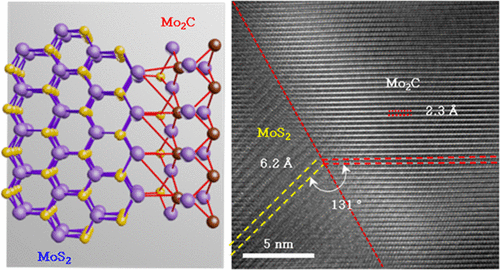Our official English website, www.x-mol.net, welcomes your feedback! (Note: you will need to create a separate account there.)
Epitaxial Synthesis of Molybdenum Carbide and Formation of a Mo2C/MoS2 Hybrid Structure via Chemical Conversion of Molybdenum Disulfide
ACS Nano ( IF 17.1 ) Pub Date : 2018-01-11 00:00:00 , DOI: 10.1021/acsnano.7b06417 Jaeho Jeon 1 , Yereum Park 2 , Seunghyuk Choi 1 , Jinhee Lee 2 , Sung Soo Lim 2 , Byoung Hun Lee 3 , Young Jae Song 1 , Jeong Ho Cho 1 , Yun Hee Jang 2 , Sungjoo Lee 1
ACS Nano ( IF 17.1 ) Pub Date : 2018-01-11 00:00:00 , DOI: 10.1021/acsnano.7b06417 Jaeho Jeon 1 , Yereum Park 2 , Seunghyuk Choi 1 , Jinhee Lee 2 , Sung Soo Lim 2 , Byoung Hun Lee 3 , Young Jae Song 1 , Jeong Ho Cho 1 , Yun Hee Jang 2 , Sungjoo Lee 1
Affiliation

|
The epitaxial synthesis of molybdenum carbide (Mo2C, a 2D MXene material) via chemical conversion of molybdenum disulfide (MoS2) with thermal annealing under CH4 and H2 is reported. The experimental results show that adjusting the thermal annealing period provides a fully converted metallic Mo2C from MoS2 and an atomically sharp metallic/semiconducting hybrid structure via partial conversion of the semiconducting 2D material. Mo2C/MoS2 hybrid junctions display a low contact resistance (1.2 kΩ·μm) and low Schottky barrier height (26 meV), indicating the material’s potential utility as a critical hybrid structural building block in future device applications. Density functional theory calculations are used to model the mechanisms by which Mo2C grows and forms a Mo2C/MoS2 hybrid structure. The results show that Mo2C conversion is initiated at the MoS2 edge and undergoes sequential hydrodesulfurization and carbide conversion steps, and an atomically sharp interface with MoS2 forms through epitaxial growth of Mo2C. This work provides the area-controllable synthesis of a manufacturable MXene from a transition metal dichalcogenide material and the formation of a metal/semiconductor junction structure. The present results will be of critical importance for future 2D heterojunction structures and functional device applications.
中文翻译:

碳化钼的外延合成和Mo的形成2 C /的MoS 2混合结构通过二硫化钼的化学转化
据报道,通过在CH 4和H 2下进行热退火,通过二硫化钼(MoS 2)的化学转化,外延合成碳化钼(Mo 2 C,2D MXene材料)。实验结果表明,调节热退火时间可通过部分转换2D半导体材料,从MoS 2提供完全转换的金属Mo 2 C和原子级尖锐的金属/半导体混合结构。Mo 2 C / MoS 2混合结表现出较低的接触电阻(1.2kΩ·μm)和较低的肖特基势垒高度(26 meV),表明该材料在未来的器件应用中作为关键的混合结构构件的潜在用途。密度泛函理论计算用于模拟Mo 2 C生长并形成Mo 2 C / MoS 2杂化结构的机制。结果表明,Mo 2 C的转化是在MoS 2边缘开始的,并经历了依次的加氢脱硫和碳化物转化步骤,并且通过Mo 2的外延生长与MoS 2形成了原子上清晰的界面C.这项工作提供了由过渡金属二卤化碳材料可制造的MXene的面积可控合成以及金属/半导体结结构的形成。目前的结果对于未来的2D异质结结构和功能器件应用至关重要。
更新日期:2018-01-11
中文翻译:

碳化钼的外延合成和Mo的形成2 C /的MoS 2混合结构通过二硫化钼的化学转化
据报道,通过在CH 4和H 2下进行热退火,通过二硫化钼(MoS 2)的化学转化,外延合成碳化钼(Mo 2 C,2D MXene材料)。实验结果表明,调节热退火时间可通过部分转换2D半导体材料,从MoS 2提供完全转换的金属Mo 2 C和原子级尖锐的金属/半导体混合结构。Mo 2 C / MoS 2混合结表现出较低的接触电阻(1.2kΩ·μm)和较低的肖特基势垒高度(26 meV),表明该材料在未来的器件应用中作为关键的混合结构构件的潜在用途。密度泛函理论计算用于模拟Mo 2 C生长并形成Mo 2 C / MoS 2杂化结构的机制。结果表明,Mo 2 C的转化是在MoS 2边缘开始的,并经历了依次的加氢脱硫和碳化物转化步骤,并且通过Mo 2的外延生长与MoS 2形成了原子上清晰的界面C.这项工作提供了由过渡金属二卤化碳材料可制造的MXene的面积可控合成以及金属/半导体结结构的形成。目前的结果对于未来的2D异质结结构和功能器件应用至关重要。



























 京公网安备 11010802027423号
京公网安备 11010802027423号